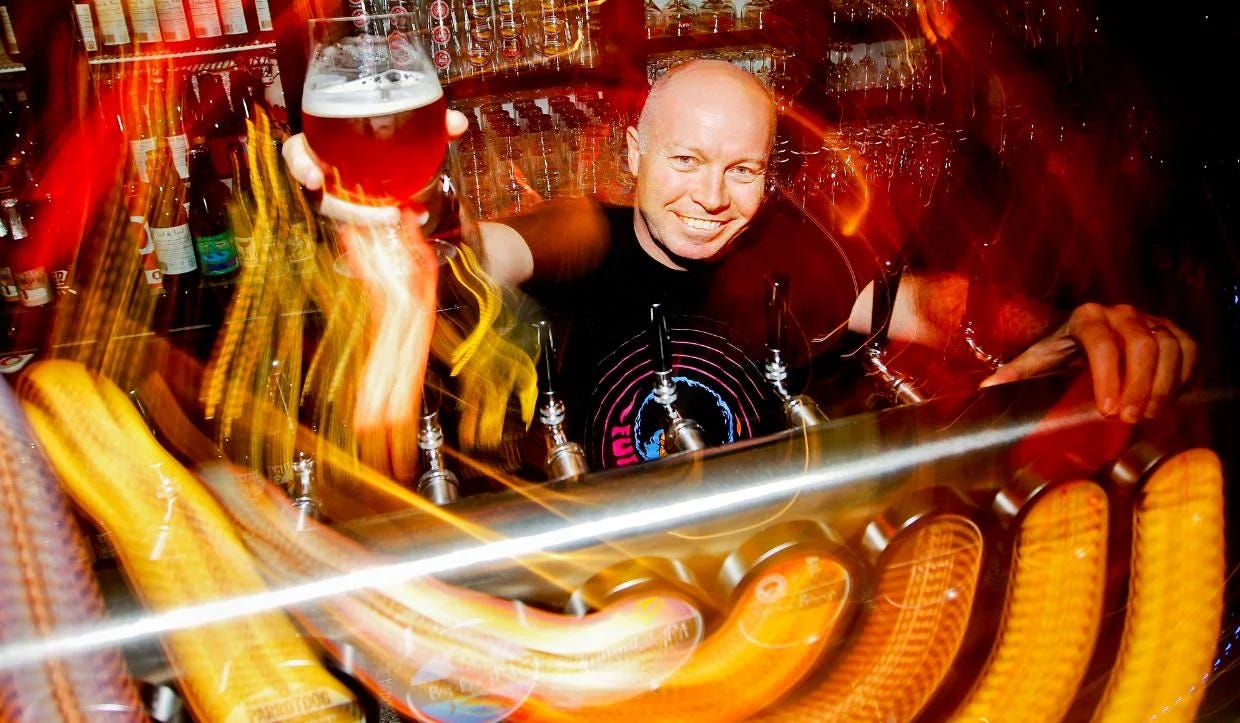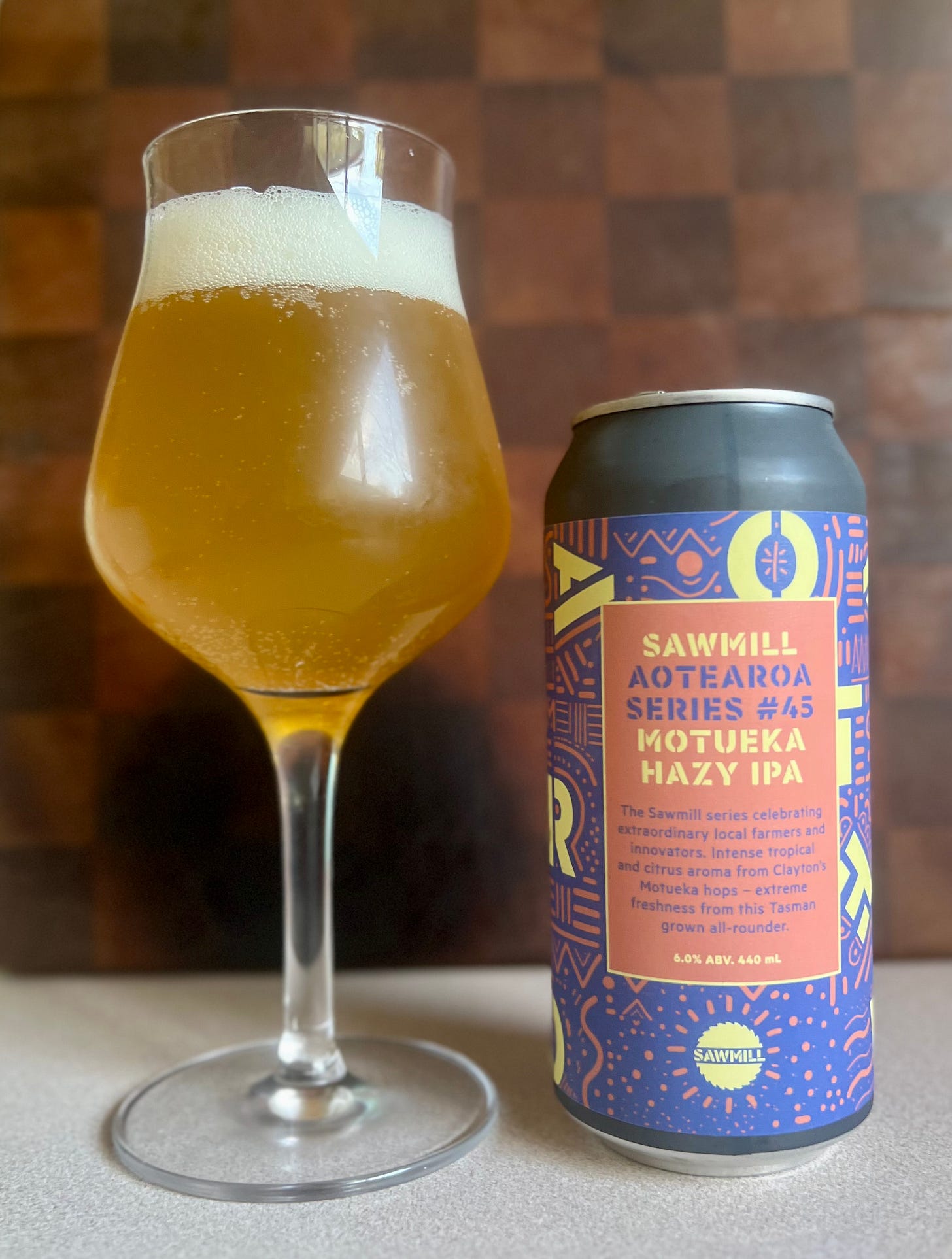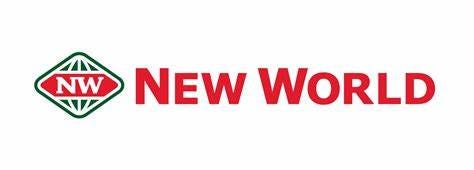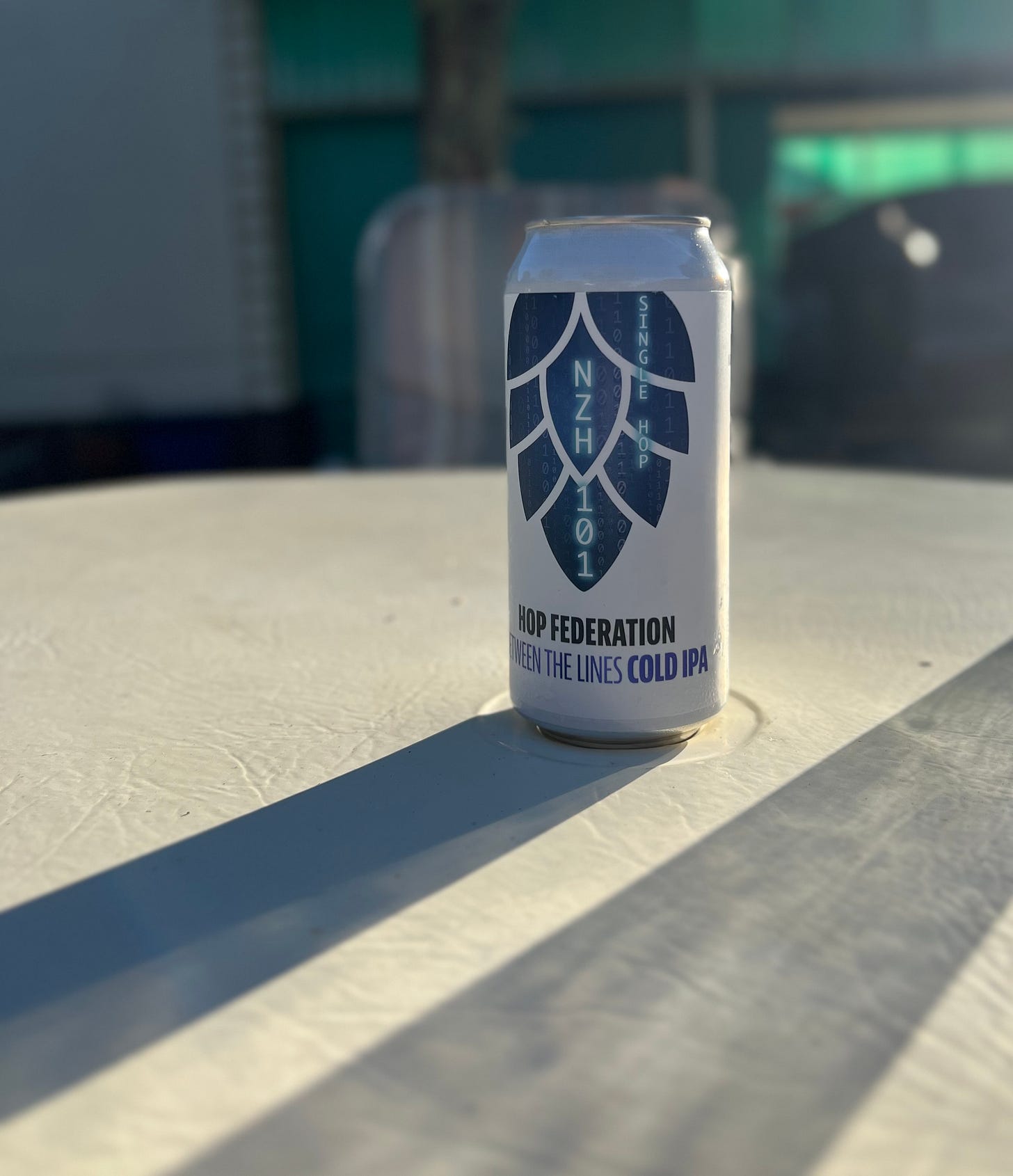Iconic Wellington craft beer bar to close
Beer production suffers biggest fall in more than decade — but it's not all bad news. Fresh hop season comes early in the Far North. A fresh hop yacht race.
Welcome to the first Friday Night Beers of autumn.
We start today with the sad news about Hashigo Zake closing down.
It’s fair to say the cult Wellington bar is responsible for incubating any number of Wellington craft beer brands, not the least Garage Project.
Hashigo Zake translates to the “liquor ladder” — which is a Japanese descriptor for a pub crawl. The bar was started by Dominic Kelly in 2009 after he’d worked in Japan and wanted to bring some of that country’s bar aesthetic back to his hometown.
Hashigo Zake was integral to much of my craft beer learning in the early days and Dominic (captured brilliantly by Stuff legend Chris Skelton in the picture below) has always been one of the wisest people in beer.
And you could say he was a visionary for taking a bet on an unheralded Garage Project — launching that brewery to the wider world through the 24/24 series in 2010. It was also where GP poured their first proper release, Pernicious Weed.
As Pete Gillespie from Garage Project told me this week, they owe a lot to the subterranean bar on Taranaki Street.
“Hashigo Zake is integral to the Garage Project story,” Gillespie said.
“We owe so much to Hashigo Zake. They took us in and gave us tap space. It was Hasihigo that offered up a Tuesday night slot for us to release our weekly drops when started off brewing 24 beers in 24 weeks and Hashigo that helped create the cult following that surrounded the 24/24.
“Hashigo will forever be woven into the story of Garage Project, and we're sad to see the end of what has been a Wellington craft beer institution.”
But Gillespie urged Wellington beer lovers to take the next week, before the official closing night on March 8 — next Friday — to “celebrate” a bar that helped drive much of the hype around Wellington’s explosive craft beer scene in the 2010s.
It's worth noting that Hashigo Zake is not closing because of the downturn in the beer market (more on that later) but because of a series of unfortunate incidents (well, two incidents and a pandemic).
First, a pump taking wastewater from the underground bar failed, leaving Kelly with a huge bill.
Then Wellington Water started digging up Taranaki St right outside the bar entry, making it hard to access.
All this is against a post-pandemic backdrop of fewer people working in the city.
“Any one and maybe even two of these crises might have been survivable for us prior to 2020, but in 2024 the cumulative effects of these blows and this decade’s other challenges mean that too much damage has been done and we have to cease trading,” Kelly told The Post this week.
If you’re in Wellington over the next week, get in there and raise a toast to a bar that was a force for good.
Beer’s biggest dip in more than a decade
Every year at the end of February, Stats New Zealand releases data on how much alcohol was available for consumption in the previous year.
The numbers are not good for beer, down 4.4% after a few years of being relatively stable, but while the bald facts look grim, I’m surprised the fall is as low as 4.4% — because mid-last year I was hearing commentary like “down 10%”.
That said, it’s the biggest annual fall for beer in more than a decade, harking back to 2012.
The anecdotal evidence, not captured here, is that this summer has been a godsend for many breweries. So — all in all — not as bad as it could have been.
Pulling apart the numbers, the biggest hits came to beer under the 4.35% ABV. That’s broken down into two categories (1.15%-2.5%) and 2.5%-4.35%.
That low alcohol category was down 5.7% and the mid-range ABV band was down 6%. It’s hard to put context around black-and-white numbers, but I’d hazard a guess that the sub-2.5% drinkers are potentially moving to non-alcoholic beer, which is not captured in this data as Stats NZ get their information from Customs & Excise. The Brewers Association noted non-alc was up 8% (off a still small base).
But the decline in the mid-range ABVs (gold band in above graph) speaks to the ongoing demise of the 4% NZ draught family of beers which includes the likes of Tui, DB Draught, Lion Red, Speight’s Gold Medal Ale, Waikato Draught etc. This category is sliding away fast. In 2009 this ABV bandwidth saw 192 million litres brewed, which was almost two-thirds of all beer (see above graph — a beer over 5% was rare 15 years ago!)
Now it’s just 71 million litres, and only a quarter of all beer. It’s not just the rise of craft that has condemned these beers towards a watery grave, but a general switch to “premium” beer — of the green-bottled kind.
The loss in the mid-range is roughly 120m litres, and that’s nearly all accounted for by increases in beer above 4.35%, which includes notable growth in the plus-5% category.
Wine, after a period of steady growth in volume in the 2010s, has seen a post-pandemic crash — falling from 113m litres in 2020 to 98m litres last year.
RTDs had a massive drop in volume but premium spirits continued their inexorable growth.
In terms of my view that it’s not all bad news, it seems the tide has turned on the beer recession as inflation pressures ease around the world. We might be lagging a bit behind here but I fully expect the pressures to ease here throughout 2024 as migration, tourism and a general upbeatness help the economy (see this week’s announcement on the Official Cash Rate).
Beer of the Week No 1
Sawmill’s dedication to a New Zealand hop-driven series is admirable and I can’t believe they’re at No 45. Motueka hops are every brewer’s favourite complimentary hop because Motueka has the ability to make everything else better, its bright lime bringing in plenty of top notes. But it’s also amazing on its own, with lemon thyme, passionfruit and pine showing up. Aotearoa No 45 is “lightly” hazy and highly delicious.
This beer, like many I review in this space, can be found at select New World stores, your home of good beer.
Hop harvest comes early in the Far North
Hop harvest is underway and generally mid-March is around the earliest we see fresh hop beers, but Phat House, based in Haruru in the Far North have stolen a march on bigger breweries thanks to the early ripening of Northland grown hops.
Phat House released their Ipipiri Sunrise Fresh Hop XPA on February 17. It’s brewed with locally-grown Orange Sunrise hops, a variety created by Monhopoly, in Rangiora, North Canterbury, and available through Wild About Hops.
Rob Harrell of Phat House is unsure whether Kerikeri’s climate or the breed of hop itself is the reason for the early harvest, but the money’s on the weather in the Far North.
And the result? A clean, crisp and dry beer with subtle hop aroma of passionfruit and orange zest and just the right textural level of grippy, grassy tannic notes. A lovely beer and very quaffable on a hot summer’s day. Best found — and drunk — at the source.
Yachts and hops
Staying with the hop harvest and I think I’ve found the most innovative way of getting hops from Nelson to Wellington: by yacht. Or more precisely via a yacht race.
Waitoa Beer, based in the Wellington suburb of Hataitai, are closely aligned with the Royal Port Nicholson Yacht Club, as one of their regulars, Dave Roberts, is the commodore of the club.
There’s a long back-story to this, which involves Roberts getting a sail made for his yacht with “Waitoa” written in huge letters — and unfurling said spinnaker inside Waitoa’s small brewpub to show everyone. If you have any idea how big a spinnaker is, and how small the Waitoa bar is, you can imagine the mayhem.
Anyway, Waitoa and the yacht club have built a strong relationship and a recent conversation over a few beers turned into a mad-cap scheme that will see four yachts racing to Mapua to pick up sacks of fresh hops and sail them back to Wellington.
Waitoa founder Mark Davey said the logistics are still being worked through, but each of the four yachts will be “time trialled” on the trip to Mapua and back. They may have to weigh anchor for a day or two in Mapua while they wait for the hops to arrive and be loaded up before racing back to Wellington.
The race is to be known as the Vine To Vat Regatta and the resulting beer, Windfall, will be a keg-only release based on a 500-litre batch. It will be launched at the yacht club.
Dusty’s Beer of the Week
Sun-drenched arvos and Townshend Pacific Lager is a winning combo! Hopped with Sorachi Ace, Cascade & Citra it’s a citrus-forward delight, with notes of mandarin, lemon & florals dancing around on a crispy clean mouthfeel before a drying finish, perfect thirst quencher.
Beer of the Week No 2
I’ve heard there are people out there who don’t love Cold IPA the same way I do. Well, if you are one of those people, let Hop Federation’s Between The Lines Cold IPA put you on the straight and narrow. The main comment I hear from the anti-Cold brigade is that the hybrid style is disjointed. This is not disjointed. This is linear, smooth, crisp, clean and delicious. The trial hop NZH-101 brings oh-so-subtle cat pee dankness, a light sprinkle of citrus and some tropical goodness. The bitterness is firm, assertive, and long but not overpowering. It’s a fantastic drop and deserves all the kudos it’s getting in the social media space.
Bud Light’s heavy year
With total beer sales here falling 4.4%, imagine how global brewing giant AB InBev is feeling about a 17.4% crash in the last quarter of 2023. Now this is a huge company we’re talking about — they own Bud Light, Stella Artois, Budweiser and Corona! They’re blaming the loss largely on the complete f*** up they created with Bud Light.
Bud Light trans boycott hammers world's biggest brewer AB InBev (telegraph.co.uk)
Beer of the Week No 3
I have to say I’ve been enjoying the beers from Small Gods recently. The decadent Christmas trio were all excellent (and big on the ABV front). Ditto the thumpingly big Arms Race (9.3% Double IPA). But their modern take on a traditional English Best Bitter, Rose & Crown, is a delightful sub-5% beer (4.9%) and reminiscent of something you might get at Galbraith’s Alehouse. With the typical rich, biscuit, toffee malt base there’s an underlying current of bitterness overlaid with two new British hops, First Gold and Harlequin that deliver sweet orange and peach as well as a herbal-spice note.
Iowa beer cave discovered
At first reading I thought this was about a “bear cave” but no, apparently the American state of Iowa has a history of subterranean tunnels and caves for fermenting and storing beer. And one was recently rediscovered in a town called Cascade (Cascade being unrelated to the Cascade hop, although Iowa does grow some hops!)
Lagunitas, a lost dog trying to find a way home
After starting with Hashigo Zake, it feels like a circle of sorts to round back to Lagunitas. My rationale here is that Dominic Kelly’s side business for a while was Beers Without Borders and he imported lots of American beers, and introduced a bunch of people like me to Rogue, Ballast Point, Pelican, Gigantic and others (and I’m sure Lagunitas would have been in there).
Anyway, since selling to Heineken in 2017 things have not been so great for the brand, as Good Beer Hunting reports.
Former employees say this reality is a result of cultural friction between corporate parent Heineken International, which wholly acquired Lagunitas for reportedly close to $1 billion in 2017, and the existing organization. Prior to the sale, Lagunitas was led by founder Tony Magee, who Chicago Magazine once labelled “a stoner savant.” Under his guidance, the brewery grew into one of the most successful craft brands in the country while embracing a countercultural spirit—and plenty of cannabis references.
Today, Lagunitas executives say they want to regain the Magee-led ideals that once defined the brand, but that attitude was a direct reflection of the company’s founder. Today, it’s longtime Heineken employees who are calling the shots, not a “dropout pothead.”
That’s all from me this week, catch you all next time around for news and new beer.
















Sorry for a very belated comment but that's a shock about Hashigo Zake. As a regular visitor to the capital in the 2010s, I often had a beer or three there with a friend while I was in town. My favourite spot was the tables beneath the small opening to the pavement on Taranaki St. And kudos to the barman who cautioned me that the bourbon-barrel conditioned stout I once ordered was 9%.